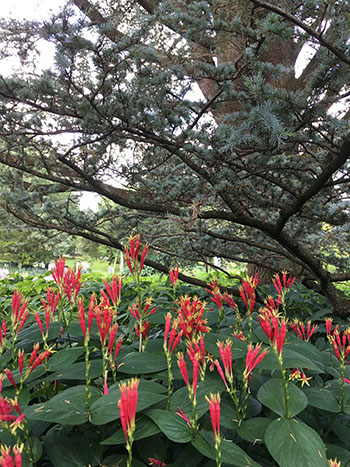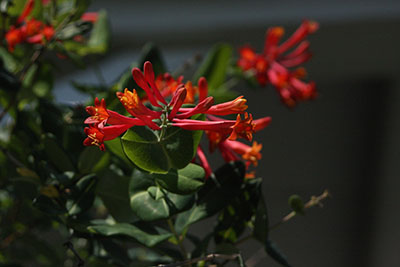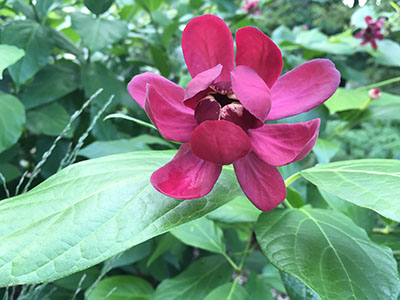
Plants of the Week: June 28
Guest Author: Julia Hackstie

As hummingbirds make their way into our gardens these first days of summer, we may be thinking of ways to provide them with supportive nectar-rich habitats to guarantee their return visits all season. If the daily maintenance of hummingbird feeders seems too daunting, using the right plants in our gardens to attract and feed hummingbirds can be an easier and more sustainable alternative. Spigelia marilandica (Indian pink), a perennial native to the southeastern U.S., attracts hummingbirds with its clusters of deep red, trumpet-shaped tubular flowers. Each flower opens on the end to reveal five reflexed lobes resembling yellow petals. The terminal clusters of flowers bloom on the spike from the bottom up. This clumping plant does well in shade to part-shade and can function as a groundcover of sorts under trees where it pairs beautifully with other shade-loving plants such as ferns and hostas. Spigelia marilandica is currently blooming and providing nectar to hummingbirds under the Cedrus atlantica (blue Atlas cedar) in the Scott Entrance Garden. Photo credit: J. Hackstie

Lonicera sempervirens ‘Leo’, our native trumpet honeysuckle vine, is another hummingbird magnet. It grabbed my attention growing up the side of the Swarthmore Friends Meeting House with its coral-red tubular flowers contrasting against the deep blue sky. ‘Leo’ is one of the reblooming varieties of Lonicera sempervirens and is coveted by hummingbirds who are drawn to its brilliant flowers which in turn provide them with rich nectar. Its flowers are reportedly red in color, but I noticed these blooms have an orange hue on the inside of the corolla.
While robust and a proliferative bloomer in full sun, it is nowhere near as aggressive as its invasive relative, the Japanese honeysuckle. As an added bonus, it is also a larval host to the gorgeous Spring Azure and fascinating Snowberry Clearwing Moth. This beauty has multi-season interest with semi-evergreen deep green foliage and blooms all summer. It is easily grown on a trellis, arbor, pergola or any sturdy structure in the garden. It can grow to twenty feet, but once established its growth and form can be controlled by routine pruning. It prefers average, well-drained soils and full sun to part-shade.
Flowers produce red berries that are an enticing food source for fruit-eating birds in the fall. I would recommend this twining vine in your perennial border on a tuteur or obelisk, or on a gated arbor at the entrance to your garden or yard. It also looks fantastic paired up with our native wisteria vine, Wisteria frutescens, on a wooden fence. Cultivars of Lonicera sempervirens can be hard to differentiate to the casual observer, but you can use the Scott Arboretum Navigator to locate and compare the varieties growing here. Photo credit: J. Hackstie

In the gardens to the northwest side of Kohlberg Hall, Calycanthus ‘Aphrodite’ (sweetshrub) has me smitten with its summer-long magnolia-like muted maroon-red blooms contrasted against lush semi-gloss apple green foliage. Introduced in 2005 from a collaborative project between NC State University and Spring Meadow Nursery, this hybrid is a cross between our west coast Calycanthus occidentalis and Calycanthus chinensis. The flowers of this hybrid are held on long pedicels and are comprised of 26-30 whorled yellow-tipped tepals. The intensity of their light fruity scent reportedly depends on the age of the bloom and time of day. At 5:00 on a hot, humid summer afternoon, the scent to me was reminiscent of somewhere between an apple or melon. Growing on average to 6 feet tall and wide, its apple-green elliptical leaves turn a lovely golden yellow in the fall. Performing best in full sun to part shade, Calycanthus ‘Aphrodite’ will add exceptionally appealing interest to your mixed shrub border or outdoor living space for months. Photo credit: J. Hackstie





Robert Roggeveen
Posted at 09:01h, 08 JulyTemptations – intrigued by the Spigelia marilandica as an addition to a garden in West Hartford, Conn. But think about how many “natives” of the SE USA do well in New England already, and Zone 7 has started to kiss the north shore of Long Island.